A) least; most
B) most; most
C) least; least
D) not; excessively
E) most; least
Correct Answer

verified
Correct Answer
verified
Multiple Choice
Compared to the hand, the foot
A) has more phalanges.
B) has fewer metatarsals than the hand has metacarpals.
C) has a more restricted range of movement.
D) contains ellipsoidal arches that help distribute body weight.
E) has the same number of tarsal bones as the hand has carpal bones.
Correct Answer

verified
Correct Answer
verified
Multiple Choice
 Figure 7-1 Floor of the Cranial Cavity
Use Figure 7-1 to answer the following questions:
-Identify the internal occipital crest.
Figure 7-1 Floor of the Cranial Cavity
Use Figure 7-1 to answer the following questions:
-Identify the internal occipital crest.
A) 1
B) 2
C) 3
D) 4
E) 5
Correct Answer

verified
Correct Answer
verified
Multiple Choice
The superior border of the ilium that acts as a point of attachment for both ligaments and muscles is the
A) anterior iliac spine.
B) acetabulum.
C) posterior superior iliac spine.
D) iliac crest.
E) iliac notch.
Correct Answer

verified
Correct Answer
verified
Multiple Choice
The sternum contains
A) the manubrium.
B) the jugular notch.
C) the body.
D) the xiphoid process.
E) all of the above
Correct Answer

verified
Correct Answer
verified
Multiple Choice
 Figure 7-4 The Humerus
Use Figure 7-4 to answer the following questions:
-Which structure articulates with the glenoid cavity?
Figure 7-4 The Humerus
Use Figure 7-4 to answer the following questions:
-Which structure articulates with the glenoid cavity?
A) 3
B) 4
C) 5
D) 6
E) 7
Correct Answer

verified
Correct Answer
verified
Short Answer
The first cervical vertebra is better known as the ________.
Correct Answer

verified
Correct Answer
verified
Multiple Choice
The primary spinal curves
A) are also called compensation curves.
B) accommodate the thoracic and abdominopelvic viscera.
C) develop several months after birth.
D) all of the above
E) none of the above
Correct Answer

verified
Correct Answer
verified
Multiple Choice
Powerful hip muscles attach posteriorly to the femur along the
A) greater trochanter.
B) lesser trochanter.
C) linea aspera.
D) medial epicondyle.
E) intercondylar fossa.
Correct Answer

verified
Correct Answer
verified
Multiple Choice
The nasal conchae
A) attach muscles that move the eye.
B) contain the nerves for olfaction.
C) create turbulence in the nasal passageways.
D) protect the pituitary gland.
E) attach muscles that move the eyelids.
Correct Answer

verified
Correct Answer
verified
Essay
Why is it necessary for the bones of the pelvic girdle to be more massive than the bones of the pectoral girdle?
Correct Answer

verified
The pelvic girdle must withsta...View Answer
Show Answer
Correct Answer
verified
View Answer
Multiple Choice
 Figure 7-3 The Scapula
Use Figure 7-3 to answer the following questions:
-Identify the structure labeled "7."
Figure 7-3 The Scapula
Use Figure 7-3 to answer the following questions:
-Identify the structure labeled "7."
A) acromion
B) scapular process
C) spine
D) coracoid process
E) scapular notch
Correct Answer

verified
Correct Answer
verified
Multiple Choice
Each of the following bones is a component of the orbital complex, except the ________ bone.
A) lacrimal
B) nasal
C) sphenoid
D) ethmoid
E) frontal
Correct Answer

verified
Correct Answer
verified
Multiple Choice
All of the following are True of the sacrum, except that it
A) provides protection for reproductive, digestive, and excretory organs.
B) provides a point of attachment for leg muscles.
C) articulates with the pelvic bones.
D) articulates with the second and third lumbar vertebrae.
E) articulates with the coccyx.
Correct Answer

verified
Correct Answer
verified
Short Answer
The nasal complex includes the bones that enclose the nasal cavity and the ________ sinuses.
Correct Answer

verified
Correct Answer
verified
Multiple Choice
The zygomatic arch is formed by the union of processes from which two bones?
A) temporal and maxilla
B) frontal and temporal
C) sphenoid and temporal
D) zygomatic and maxilla
E) temporal and zygomatic
Correct Answer

verified
Correct Answer
verified
Multiple Choice
What organ is located in the lacrimal fossa?
A) the pituitary gland
B) the inner ear
C) tear gland
D) the lacrimal ramus
E) the frontal sinus
Correct Answer

verified
Correct Answer
verified
Multiple Choice
 Figure 7-5 The Femur
Use Figure 7-5 to answer the following questions:
-Identify the diaphysis of the femur.
Figure 7-5 The Femur
Use Figure 7-5 to answer the following questions:
-Identify the diaphysis of the femur.
A) 1
B) 2
C) 3
D) 5
E) 7
Correct Answer

verified
Correct Answer
verified
Multiple Choice
As the result of an accident, Bill suffers a dislocated jaw. This injury would involve the
A) stylohyoid ligaments.
B) hyoid bone.
C) condylar process of the mandible.
D) alveolar process of the mandible.
E) greater cornu of the hyoid bone.
Correct Answer

verified
Correct Answer
verified
Multiple Choice
If there were no paranasal sinuses, all of the following would be True , except
A) the skull would be heavier.
B) stronger neck muscles would be required.
C) less mucus in the nasal cavity.
D) reduced ability to trap dust and particles.
E) the ability to sneeze would be impaired.
Correct Answer

verified
Correct Answer
verified
Showing 141 - 160 of 205
Related Exams